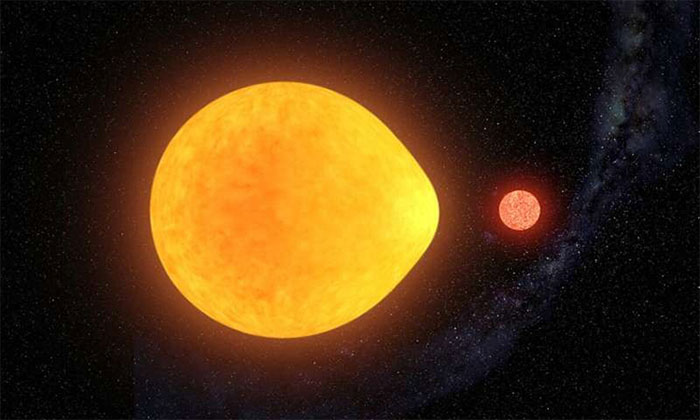The first time discovered the water drop star
Due to the impact of gravity in the binary star system, the HD74423 star in the Milky Way is pulled deformed on one side of the hemisphere.

Graphic simulating water droplet star with red dwarf companion.(Photo: Gabriel Pérez Díaz).
The discovery was led by international astronomers led by Dr. Simon Murphy from the University of Sydney, Australia, using NASA's TESS extraterrestrial hunting space telescope. The star weighs 1.7 times the Sun and lies about 1,500 light-years from Earth.
"The first thing that caught our attention was that HD74423 was chemically bizarre," Murphy said. "Stars like this are usually rich in metal but HD74423 is the opposite, making it a rare hot star."
HD74423 is classified as a heartbeat star - the term for double star variables (whose light changes periodically) caused by the gravitational attraction of the companion star. In binary stars, when one star has an elliptical orbit that moves closer to the other star, gravity pulls it into a non-spherical shape, changing the brightness. However, all previously known heart rate stars are deformed on both sides of the hemisphere. HD74423 is the first case to deform only on one side, giving it a unique teardrop shape.
Astronomers, in theory, have been skeptical of the existence of teardrop-shaped heart stars since the 1980s . "We have been looking for such a star for nearly four decades but have now discovered it," said Don Kurtz, co-author of the study from Central Lancashire University in the UK.
In the case of HD74423, its unusual shape is caused by a companion smaller dwarf star. The two stars orbit very quickly, at close distances, with each round taking less than two days. This causes the larger star to become deformed as a teardrop. Details of the study were published in the journal Nature Astronomy on March 9.
- For the first time, a star has been discovered in a star
- Spot the star shooting 'water bullets' in the universe
- Video: Drop the camera in hot water to spin boiled eggs
- Drop Japanese Koi fish into To Lich River and West Lake to demonstrate water quality
- The scientists were skeptical of discovering Star Death
- The neutron star collision is 520 million light-years from Earth
- The mysterious age of the mysterious star
- The star is nearly 2,000 times bigger than the Sun, lighter than water
- Water was discovered outside the solar system for the first time
- 'Dry' water and special applications
- The star is brighter than the Sun.
- The first time a revived star was discovered
 Van Allen's belt and evidence that the Apollo 11 mission to the Moon was myth
Van Allen's belt and evidence that the Apollo 11 mission to the Moon was myth The levels of civilization in the universe (Kardashev scale)
The levels of civilization in the universe (Kardashev scale) Today Mars, the sun and the Earth are aligned
Today Mars, the sun and the Earth are aligned The Amazon owner announced a secret plan to build a space base for thousands of people
The Amazon owner announced a secret plan to build a space base for thousands of people